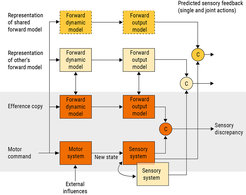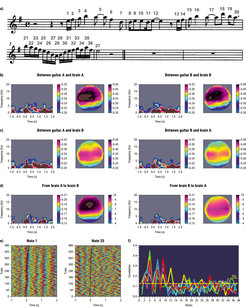Interactive Brains, Social Minds
(Concluding Report)
Research Scientists
Viktor Müller
Julia Delius
Ulman Lindenberger
In everyday life, people often coordinate their actions. Examples include walking with someone, doing team sports, dancing, and playing music in a duet or group, as well as social bonding behaviors, such as gaze coordination between mother and infant or between partners. The developmental and social significance of these interpersonally coordinated behaviors is undisputed, but little is known about the brain mechanisms that regulate their temporal dynamics. The Interactive Brains, Social Minds project investigates behavioral, somatic, and neural mechanisms that permit individuals to coordinate their behavior in time and space (see Figure 1).

Figure 1. A forward model of interpersonal action coordination. Drawing on the work of Steven M. Boker, Wolfgang Prinz, Daniel Wolpert, and others, our model assumes that interpersonal action coordination is based on a set of linked representational layers. The single-person layer is shaded in gray. Individuals acting together attempt to synchronize their forward model regarding their own actions with their forward model regarding the other person’s actions. Highly skilled individuals, such as dancers or musicians, may represent jointly performed activities as a unified suprapersonal action with a joint forward model and partially joint sensory feedbacks. The various representational layers of the actors are intertwined by sensorimotor feedback loops (Müller et al., 2021).
Since its inception in 2004, the project has focused on analyzing electroencephalographic (EEG) data of skilled musicians playing together, based on the observation that this goal-directed activity imposes high demands on the precision of interpersonal action coordination (Lindenberger et al., 2009). During the reporting period, we replicated and extended our finding that within-brain synchrony and between-brain oscillatory couplings precede and accompany guitar duet playing, and explored the neural and behavioral dynamics of interpersonal action coordination during free improvisation. We found that guitarists’ brains during improvisation synchronize with slow-frequency modulations of their acoustic signals (Müller & Lindenberger, 2022). The phase angles of the two guitarists’ EEG signals were aligned with the corresponding behavioral onset asynchronies, confirming the results of Lindenberger et al. (2009). These findings validate the hypothesis that brain–behavior entrainments reflect the temporal dynamics of coordinated musical performance, and that inter-brain synchrony supports interpersonal action coordination (see Figure 2).

Figure 2. Brain–guitar and brain–brain coupling as well as phase alignment in guitarist duos using a multi-trial design. (a) Adapted version of a modern jazz-fusion piece, "Fusion #1,” composed by Alexander Buck and adapted by the lead guitarist, Thomas Holzhausen. The notes played are numbered. (b) Time–frequency diagrams (locked to the onset of play) and topological distribution of grand average phase coherence (PC) between the guitarists’ brains and their own instruments, depicted for guitarists A and B separately. The topological distribution of coupling showed the maxima at left central sites of both guitarists, apparently indicating the influence of cortical activity related to the right hand. (c) Time–frequency diagrams and topological distribution of grand average PC between the guitarists’ brains and the other guitarists’ instruments, also depicted for guitarists A and B separately. Here, the topological distribution showed centro-parietal and temporal maxima without visible cortical asymmetry, apparently indicating influence of hearing and motor actions of left and right hands in both guitarists. (d) Time–frequency diagrams of grand average PC and topological distribution of strengths (a sum of all connections from one electrode to all other electrodes in the other brain) of the between-brain connectivity for guitarists A and B. The topological distribution of strength in the lead guitarist A is focused at mid fronto-central sites, while in guitarist B they are more broadly distributed across fronto-central and parietal sites. (e) Phase alignment of phase angles related to the behavioral play-onset asynchrony across all trials and guitarist pairs for two selected notes (1 and 25) for guitarist A. Trials were sorted by behavioral onset asynchrony between the players (guitarist A’s play onset time minus guitarist B’s play onset time). Behavioral synchrony is depicted by the black curve. Phase alignment was calculated here for the mid-central electrode Cz. The results indicate a strong phase alignment that closely follows the behavioral onset asynchrony across all trials and guitarists in the pairs. (f) Angular-linear correlation between phase and time differences across all trials and guitarist pairs for each of the notes played. The correlation is strongest for the first 12 notes of the music piece (especially for notes 4, 7, and 9) at practically all six harmonics of the metronome frequency. Correlation values for this representation were calculated between the Cz electrodes in guitarist A’s and B’s brains (see Müller & Lindenberger, 2022, for details).
Image: MPI for Human Development
Adapted from Müller & Lindenberger (2022)
Original image licensed under CC BY-NC 4.0
We also explored the properties of hyper-frequency, hyper-brain networks within couples engaged in romantic kissing (Müller, 2022). Hyper-brain network strengths were higher and characteristic path lengths were shorter when individuals were kissing each other than when they were kissing their own hand. Between-brain strengths of theta oscillations (around 5 Hz) were reliably associated with reported partner-oriented kissing satisfaction, especially over frontal and central electrodes. Adding to our observations of fronto-central between-brain synchronization in guitar duet players, we surmise that the observed networks might reflect the operation of cell assemblies representing movement coordination among interacting partners (see Figure 1).
The project has also sought to devise new EEG paradigms that manipulate the degree of interbrain synchrony more directly. In one such paradigm (Müller et al., 2021), participants are asked to control interbrain synchrony by using visual neurofeedback that is provided visually on a computer screen, either as two balls approaching each other or as two pendula, each reflecting the oscillatory activity of one of the two participants. Neurofeedback was provided in real time at their delta and theta EEG frequencies. Participants were able to increase interbrain synchrony by using neurofeedback, especially when provided at the theta frequency. Apart from intra- and interbrain coupling, other aspects of oscillatory activity (e.g., power spectral density, peak amplitude, and peak frequency) also differed during task relative to rest. Moreover, several of these brain-derived measures were correlated with self-report items assessed after the experiment, such as momentary well-being, likeability of the experimental partner, and estimated capability to influence the task. These initial results suggest that neurofeedback might help in specifying the contribution of interbrain synchrony to interpersonal action coordination.
Finally, we also revisited data from a choir of 11 singers and their conductor, originally published in 2011 (Delius & Müller, 2023). Based on an integrated analysis of respiratory, cardiac, gestural, and vocalizing subsystems, we conclude that the choir members constitute the choir as a hyper-system space or superorganism, marked by the simultaneous presence of upward and downward causation. Each singer contributes to the choral singing through his or her voice and influences the function of the choir as a whole (upward causation). At the same time, the whole choir functions as a superordinate system, or superorganism, that imposes boundary conditions on each individual singer (downward causation).
Key References

